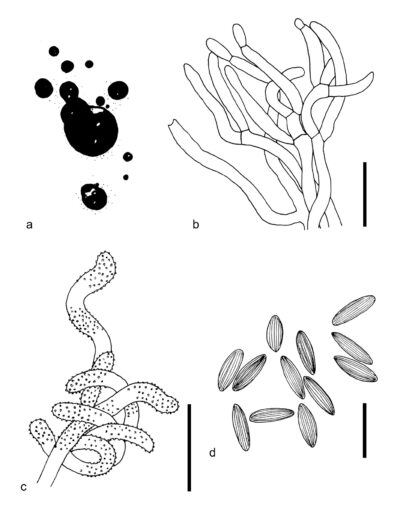Fungalpedia – Note 325, Striaticonidium
Striaticonidium L. Lombard & Crous
Citation when using this entry: Perera et al. 2024 (in prep) – Fungalpedia, genera described in 2016.
Index Fungorum, Facesoffungi, MycoBank, GenBank, Fig. 1
Classification: Stachybotryaceae, Hypocreales, Hypocreomycetidae, Sordariomycetes, Pezizomycotina, Ascomycota, Fungi.
Based on the phylogenetic analysis of cmdA, ITS, rpb2 and tub2 loci, Lombard et al. (2016) introduced Striaticonidium to accomodate a group of myrothecium-like taxa that have striate conidia. Striaticonidium is characterized by synnematous or sporodochial conidiomata or simple conidiophores. Synnemata are cylindrical to pyriform, unbranched, broadening towards the apex and covered by an olivaceous green to black slimy mass of conidia. They consist of bundles of parallel, longitudinal, closely compacted hyphae that are terminating in whorls of 2–4 conidiogenous cells. Marginal hyphae of synnemata are olivaceous green, verrucose, sinuous and terminating in a blunt apex. Sporodochia are stromatic, superficial, scattered or gregarious, oval or irregular in outline, with a white to grey setose fringe surrounding an olivaceous green to dark green slimy masses of conidia. Stroma are poorly- or well-developed, hyaline with globulosa or angularis texture. Simple conidiophores consist of conidiogenous cells arising directly from vegetative hypha, solitary or rarely in groups. Setae are short, septate, sinuous, subhyaline to olivaceous green, thin-walled, verrucose and have an obtuse apex. Conidiophores have smooth to verrucose walls, are macronematous, verticillately or penicillately branched and hyaline. Conidiogenous cells are phialidic, cylindrical to subcylindrical, hyaline and smooth-walled. They have prominent collarettes and periclinal thickenings. Striaticonidium species produce fusiform to ellipsoidal conidia, which are aseptate, olivaceous green to brown, and longitudinally striate. The apical hilum of the conidia lacked funnel-shaped mucoid apical appendages. The sexual morph remains undetermined (Lombard et al. 2016). Striaticonidium species are associated with soil and plant parts, and the genus currently comprises five species (Lombard et al. 2016; Crous et al. 2017).
Type species: Striaticonidium cinctum (Corda) L. Lombard & Crous
Other accepted species: Species Fungorum, search Striaticonidium
Figure 1 – Striaticonidium cinctum (CBS 932.69, ex-epitype). a Sporodochial conidiomata on SNA. b Conidiogenous cells. c Setae. d Conidia. Scale bars: b–d = 10 μm. Redrawn from Lombard et al. (2016)
References
Entry by
Rekhani Hansika Perera, Center of Excellence in Fungal Research, Mae Fah Luang University, Chiang Rai, 57100, Thailand.
(Edited by Kevin D. Hyde, Samaneh Chaharmiri-Dokhaharani, & Achala R. Rathnayaka)
Published online 27 August 2024
